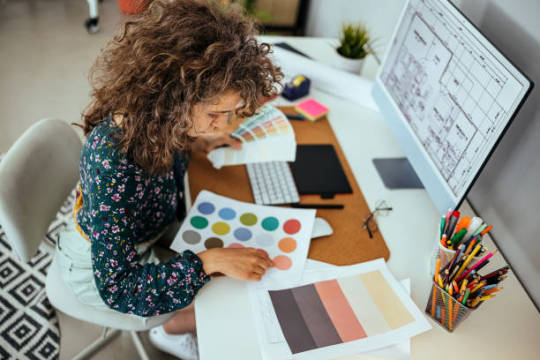Text
How Do Textures And Patterns Contribute To Interior Design?
Exploring the realm of interior design is like venturing into a vast garden of visuals where textures and patterns play pivotal roles. These elements are not just mere additions; Interior Design in Swansea IL shapes our perceptions, sets moods, and fundamentally transforms spaces. As we delve deeper, you'll see how they contribute to the aesthetics and functionality of any room.

The Impact of Textures on Space Perception
Did you know textures can significantly influence how large or cozy a room feels? Rough textures, for instance, tend to make a space feel more intimate and grounded, while smooth textures can make a room appear larger and more airy. This is crucial in interior design, especially when dealing with spaces that have size limitations. Cleverly using a plush rug or a soft, knitted throw can transform a stark room into a welcoming retreat. On the other hand, sleek leather and polished surfaces reflect more light and can make a small room seem spacious.
Patterns: Bringing Life to Rooms
Patterns are the heartbeat of a room's design narrative. Whether it's a striped wallpaper, a geometric fabric, or a floral print, patterns inject personality and movement into a space. They are essential in breaking the monotony of single-colored walls, adding layers of depth and intrigue. Thus, a well-chosen pattern can combine various elements of a room, creating a cohesive look that feels intentional and well-curated.
Texture in Natural Light
Natural light can dramatically affect the appearance of textures within a room. Light streaming through a window can enhance the intricacy of a woven tapestry or cast subtle shadows on a dimpled throw pillow, adding depth and character. So, if you're exploring Interior Design Services near me, consider how natural illumination can cast subtle shadows on a dimpled throw pillow, adding depth and character. How light interacts with different surfaces can transform the feel of a space throughout the day, making textures an integral part of thoughtful interior design.
Mixing and Matching with Mastery
The art of combining different textures and patterns can feel like a high-stakes balancing act. But get it right, and the payoff is huge. The key is to maintain harmony. For instance, if you choose a bold pattern, keep the surrounding textures subdued. Or, if you're playing with multiple textures, stick to a more neutral pattern palette. This balance ensures that the room feels neither chaotic nor bland but just right.
Trends in Textures and Patterns
In the ever-changing area of interior design, you need to know about the newest trends. However, organic textures are all the rage, emphasizing sustainability and connection with nature. Think bamboo, reclaimed wood, and handcrafted pieces. In patterns, there's a noticeable shift towards—bold, large-scale prints that command attention and encourage individual expression.
Psychological Effects of Textures and Patterns
Textures and patterns do more than decorate a space; they affect our psychology. Soft, warm textures can make us feel safe and comforted, while bold patterns can energize and inspire us. This psychological impact is why Interior Design in Swansea IL choices are essential—they don't just change spaces; they change how we feel within them.
Historical Patterns in Modern Spaces
Incorporating historical patterns into modern spaces can create a dialogue between the old and the new. A Victorian floral wallpaper bridges eras and introduces a timeless elegance when paired with contemporary furniture. By putting them together in this way, they honor the past while giving old designs new life and making them useful in today's creative settings.
Patterns as Focal Points
Patterns have a unique ability to command attention and become the focal point of a room. A large, bold pattern on an accent wall or a vibrant, patterned rug can anchor the space and draw the eye. It's not just about the pattern itself but how it interacts with the rest of the room's design elements to create a focal point that is both striking and harmonious.
The Role of Contrast in Interior Design
Contrast is a very useful tool for interior design when you use colors and patterns. Imagine walking into a room where a smooth, polished marble floor meets a rugged, textured brick wall. This contrast defines spaces and highlights their features, making each element stand out. For those seeking expert advice, Home Staging Companies in Swansea IL can help you achieve this dynamic balance. It's about finding the right balance, where every texture and pattern has its place yet stands out to create a dynamic and visually interesting environment.
Textures for Sensory Experience
It's not enough to create a room's look; you must also consider how it makes you feel. Textures make a big difference in how a room feels to the senses. A soft velvet sofa invites relaxation, while a coarsely woven ottoman may add rustic charm. These tactile elements ensure that the space is visually pleasing, comfortable, and engaging for its occupants.
Balancing Act in Interior Design
Finding the right mix between different textures and patterns in interior design is important. It's about mixing things to make unity without being boring. Clothes, fur, and leather can all work together in a place without making it feel too crowded. This balancing act makes sure that each piece fits into a cohesive but interesting design plan and that each part has a chance to shine.

Final Thoughts:
In wrapping up, textures and patterns are not just decorative elements but foundational components that add depth, interest, and function to interior design. They help tell a story, evoke emotions, and make a space visually appealing and a comfortable haven that resonates with the personalities of those inhabiting it. By contacting Larissa Staging & Design, you will ensure that these elements adapt, reflecting not just individual tastes but broader social trends and cultural shifts.
#Interior Design in Swansea IL#Home Staging Companies in Swansea IL#Interior Design Services near me#Home Staging Companies near me#Interior Designer near me
1 note
·
View note